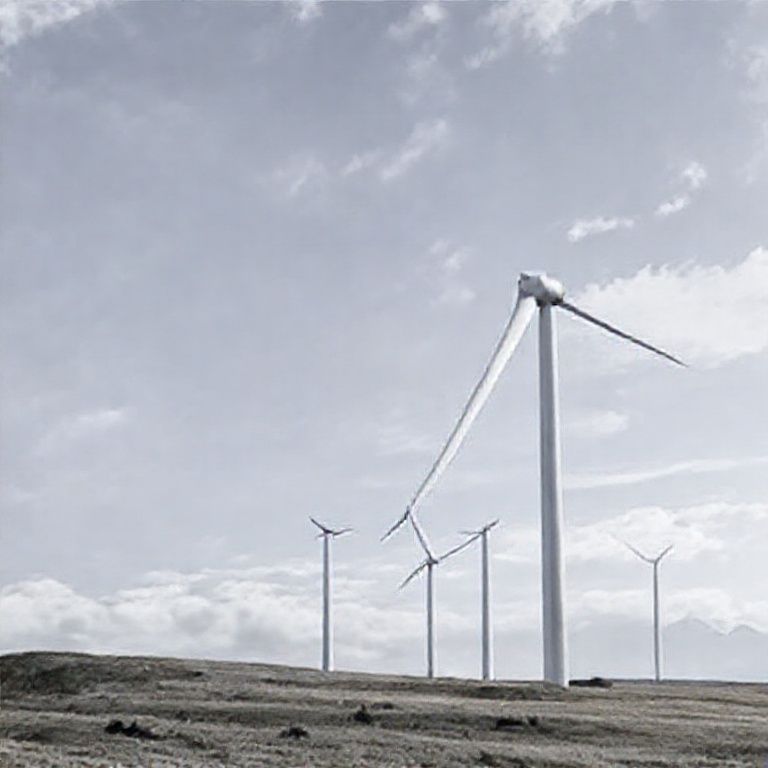The renewable energy sector, particularly wind power, faces unique challenges in ensuring asset integrity and operational efficiency. This article delves into the strategic application of Risk-Based Inspection (RBI) planning for wind turbines, a methodology crucial for optimizing maintenance schedules, mitigating potential failures, and maximizing return on investment in this critical industry.
Risk-Based Inspection (RBI) Planning for Wind Turbines: Enhancing Reliability and Operational Efficiency
The burgeoning wind energy sector, a cornerstone of global decarbonization efforts, is increasingly reliant on robust asset management strategies to ensure long-term performance and economic viability. Wind turbines, complex electro-mechanical systems operating in demanding environments, are susceptible to a range of degradation mechanisms that can compromise their integrity and lead to costly failures. Traditional time-based inspection approaches often prove inefficient and resource-intensive, leading to either over-inspection or, more critically, under-inspection of high-risk components. This is where Risk-Based Inspection (RBI) planning emerges as a transformative methodology, shifting the focus from fixed schedules to a data-driven, risk-informed approach for maintaining the health and reliability of wind turbine assets.
RBI is a proactive maintenance strategy that prioritizes inspection and maintenance efforts based on the probability of failure and the potential consequences of that failure. For wind turbines, this translates to a systematic evaluation of critical components, such as the gearbox, rotor blades, generator, tower, and foundation, to determine their inherent risks. By understanding these risks, operators can allocate resources more effectively, ensuring that inspections and maintenance are performed when and where they are most needed, thereby minimizing downtime, reducing operational expenditures, and enhancing overall safety.

Understanding the Core Principles of RBI for Wind Turbines
The fundamental tenets of RBI revolve around assessing two primary factors for each component or system within a wind turbine: the probability of failure (PoF) and the consequence of failure (CoF).
– Probability of Failure (PoF): This quantifies the likelihood that a component will fail within a given timeframe. For wind turbines, PoF is influenced by a multitude of factors:
– Design and manufacturing quality: Material defects, design flaws, and suboptimal manufacturing processes can significantly increase the inherent probability of failure.
– Operating conditions: Factors such as wind speed variability, extreme weather events (e.g., lightning strikes, icing), temperature fluctuations, and operational loads (e.g., start-stop cycles, grid connection transients) all contribute to stress on components.
– Environmental factors: Salinity in offshore environments, corrosive atmospheres, and abrasive dust can accelerate material degradation.
– Age and operational history: Components that have been in service for longer periods, or those with a history of operational issues, generally exhibit a higher PoF.
– Maintenance history: The effectiveness and timeliness of past maintenance activities directly impact the current PoF.
– Material properties and degradation mechanisms: Understanding fatigue, corrosion, erosion, creep, and other degradation mechanisms specific to wind turbine materials is crucial.
– Consequence of Failure (CoF): This assesses the severity of the impact should a component fail. For wind turbines, consequences can be categorized as:
– Safety: Catastrophic failures can pose significant risks to personnel working on or near the turbine, as well as to the public in the vicinity.
– Environmental: Turbine failures can lead to environmental damage, such as oil spills from gearboxes or structural collapse impacting ecosystems.
– Economic: This is a broad category encompassing several aspects:
– Production loss: Downtime directly translates to lost revenue from electricity generation.
– Repair costs: The cost of replacing or repairing damaged components, including specialized labor and equipment.
– Asset damage: A failure in one component can cascade and damage other parts of the turbine, leading to exponentially higher repair bills.
– Reputational damage: Frequent failures can damage the operator’s reputation and impact future project financing or power purchase agreements.
– Decommissioning costs: In severe cases, a complete turbine failure might necessitate costly decommissioning and removal.
By systematically evaluating PoF and CoF for each component, an RBI program allows operators to assign a risk level to each part of the wind turbine. This risk level then guides the development of an optimized inspection and maintenance strategy.
Key Components of a Wind Turbine RBI Program
Developing and implementing an effective RBI program for wind turbines requires a structured approach that encompasses several key elements.
1. Asset Characterization and Data Collection
The foundation of any RBI program is a comprehensive understanding of the assets being managed. This involves:
– Component identification and criticality assessment: Identifying all critical components within the wind turbine and classifying them based on their functional importance and potential for failure.
– Data acquisition: Gathering all relevant historical and current data pertaining to each component. This includes:
– Manufacturer specifications and design documentation.
– Operational data: SCADA (Supervisory Control and Data Acquisition) system logs, including wind speed, power output, temperature, vibration levels, and alarm history.
– Maintenance records: Inspection reports, repair logs, and parts replacement history.
– Environmental data: Historical weather patterns, site-specific environmental conditions.
– Material properties and certifications.
– Previous inspection reports and non-destructive testing (NDT) results.
2. Risk Assessment Methodology
This is the core of the RBI process, where PoF and CoF are systematically evaluated. Several methodologies can be employed, often tailored to the specific needs of the operator and the complexity of the assets.
– Qualitative RBI: This approach uses expert judgment and descriptive scales to assess PoF and CoF. It is often a starting point for simpler assets or when detailed quantitative data is limited. Categories might include “low,” “medium,” and “high” risk.
– Semi-quantitative RBI: This method assigns numerical values or scores to PoF and CoF based on predefined criteria. These scores are then combined to generate a risk matrix, providing a more objective risk ranking.
– Quantitative RBI (Q RBI): This is the most sophisticated approach, utilizing statistical models and engineering analysis to calculate numerical probabilities and consequences. Q RBI often involves detailed failure analysis, reliability modeling, and consequence modeling. For wind turbines, Q RBI can be particularly valuable for critical components like gearboxes and blades where complex failure modes exist.
Factors Influencing Probability of Failure (PoF) in Wind Turbines
– Load spectrum analysis: Understanding the cumulative fatigue damage from operational loads.
– Environmental degradation modeling: Predicting the rate of corrosion, erosion, or UV degradation.
– Component age and wear-out: Utilizing Weibull analysis or other reliability models.
– Condition monitoring data: Trend analysis of vibration, temperature, and oil analysis data.
– Manufacturing defects and material imperfections: Insights from NDT and material testing.
Factors Influencing Consequence of Failure (CoF) in Wind Turbines
– Safety impact: Evacuation procedures, proximity to populated areas, potential for falling debris.
– Economic impact: Estimated downtime, repair costs, replacement part availability, insurance policies.
– Environmental impact: Proximity to sensitive ecosystems, potential for hazardous material release.
– Operational dependencies: Impact on grid stability and other turbines in the farm.
3. Inspection Planning and Optimization
Once the risk assessment is complete, the RBI program dictates the inspection strategy. This involves:
– Determining inspection intervals: Components with higher risk levels will be scheduled for more frequent inspections, while lower-risk components may have extended intervals or be subject to less intensive inspection methods.
– Selecting appropriate inspection techniques: The choice of inspection method should be aligned with the identified degradation mechanisms and the criticality of the component. This can include:
– Visual inspections (borescope, drone-based).
– Non-Destructive Testing (NDT): Ultrasonic testing (UT), eddy current testing (ECT), magnetic particle testing (MT), liquid penetrant testing (PT) for structural integrity.
– Vibration analysis for gearbox and bearing health.
– Oil analysis for gearbox and hydraulic system condition.
– Thermography for identifying hot spots in electrical components.
– Blade condition assessments (aerodynamic performance, structural integrity).
– Electrical system diagnostics.
– Defining inspection scope and criteria: Clearly outlining what needs to be inspected, the acceptance criteria, and the required documentation for each inspection.
– Optimizing maintenance activities: RBI can also inform proactive maintenance tasks, such as lubrication schedules, filter changes, and minor component replacements, based on risk profiles rather than fixed timelines.
4. Data Management and Feedback Loop
A robust data management system is essential for the success of an RBI program. This system should facilitate:
– Centralized storage of all asset data, inspection records, and risk assessments.
– Easy retrieval and analysis of historical data to track trends and identify emerging issues.
– A feedback mechanism to update risk assessments based on new inspection findings, operational experience, and failure events. This continuous feedback loop is critical for refining the RBI model and ensuring its ongoing relevance and effectiveness.
– Integration with computerized maintenance management systems (CMMS) for seamless scheduling and work order generation.
Benefits of Implementing RBI for Wind Turbine Operations
The strategic adoption of RBI planning for wind turbines yields significant advantages for operators and stakeholders in the renewable energy sector.
– Enhanced safety: By prioritizing the inspection and maintenance of components with a high probability of failure and severe consequences, RBI significantly reduces the likelihood of catastrophic failures, thereby protecting personnel and the public.
– Reduced operational costs: RBI optimizes maintenance expenditure by focusing resources on the most critical areas. This avoids unnecessary inspections and maintenance on low-risk components, leading to substantial cost savings. It also minimizes the risk of expensive emergency repairs and major component replacements.
– Increased asset reliability and uptime: By proactively identifying and addressing potential issues before they lead to failure, RBI enhances the overall reliability of wind turbines. This translates to increased operational uptime and maximized energy generation, thereby improving the economic performance of the wind farm.
– Extended asset lifespan: Regular, targeted inspections and timely maintenance, guided by RBI principles, help to mitigate degradation mechanisms and prevent premature wear, ultimately extending the operational lifespan of the wind turbines.
– Improved decision-making: RBI provides a data-driven framework for making informed decisions regarding maintenance strategies, capital expenditure for asset upgrades, and risk mitigation measures.
– Regulatory compliance: Many regulatory bodies and industry standards are increasingly emphasizing risk-based approaches to asset integrity management, making RBI a key component for ensuring compliance.
– Optimized resource allocation: By understanding the risk profile of different components, operators can more effectively allocate skilled personnel, specialized equipment, and spare parts to where they are most needed.
Challenges and Considerations in RBI Implementation
While the benefits of RBI are compelling, its successful implementation requires careful consideration of potential challenges:
– Data availability and quality: The accuracy and completeness of the data collected are paramount. Inconsistent or insufficient data can lead to inaccurate risk assessments.
– Expertise and training: Implementing and managing an RBI program requires skilled personnel with expertise in risk assessment methodologies, engineering analysis, and data management. Adequate training is crucial for all involved.
– Software and system integration: Implementing RBI often necessitates specialized software for risk assessment, data analysis, and integration with existing CMMS.
– Initial investment: Setting up a robust RBI program may require an initial investment in software, training, and potentially specialized inspection equipment.
– Cultural shift: Moving from a traditional time-based approach to a risk-based mindset can require a cultural shift within the organization, emphasizing data-driven decision-making and proactive risk management.
– Dynamic nature of risk: The risk profile of a wind turbine can change over time due to operational factors, environmental changes, and component aging. The RBI program must be dynamic and continuously updated to reflect these changes.
In conclusion, Risk-Based Inspection (RBI) planning is an indispensable strategic tool for the modern wind energy industry. By moving beyond conventional, time-based maintenance schedules, RBI empowers operators to proactively manage asset integrity, optimize resource allocation, and significantly enhance the safety, reliability, and economic performance of their wind turbine fleets. The systematic evaluation of failure probabilities and consequences, coupled with continuous data analysis and feedback, forms the bedrock of an effective RBI program, ensuring that wind turbines operate at peak efficiency and contribute effectively to a sustainable energy future.








